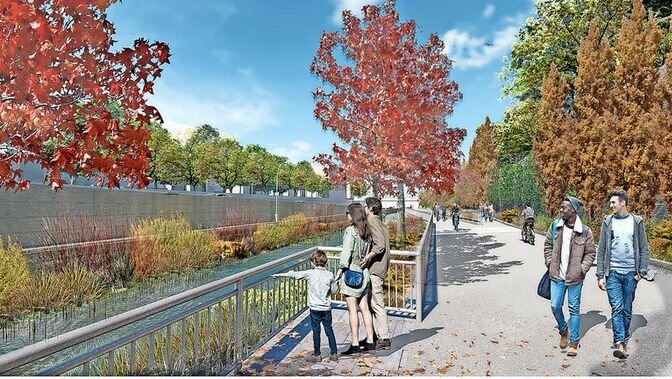Project to unearth Tibbetts Brook in final stages
A city project that will bring more green space to Kingsbridge and address sewer and wastewater problems has finally been approved. The proposal will “daylight” Tibbetts Brook, meaning a portion of the brook that currently runs underground will be brought back up above ground.
Tibbetts Brook starts in Westchester’s city of Yonkers and runs through Van Cortlandt Park before emptying into the Harlem River.
Daniel Rowen, chair of Community Board 8’s environment and sanitation committee, said this project has been in discussion since the 1990s and was finally included in the Van Cortlandt Park Master Plan in 2014. It was then moved up to become part of New York City’s Green Infrastructure plan in 2018.
“Hurricane Ida in 2021 caused excessive flooding in the area and showed everyone how important this project could be for storm-water prevention plans,” Rowen said.
The current plan is to bring the section of the brook from Van Cortlandt Park South to West 230th Street above ground and set alongside a newly built greenway with a pedestrian and bike path that will be beautified with plants.
Part of what took the project so long was the city needed to acquire a portion of land next to the Major Deegan Expressway owned by CSX Transportation, a freight railroad company, for $11.2 million.
Currently, combined sewage overflow, in which sewers become overburdened or inundated with water, is a major problem for the Harlem River. Sewer water with nowhere else to go empties into the river, filling it with contaminants.
Typically, the water from Tibbetts Brook enters the sewer system at about 4 million to 5 million gallons of water per day, where it continues on to the Wards Island Wastewater Resource Recovery Facility.
But when combined sewage overflow happens, the water bypasses this system, causing it to empty into the river unfiltered and riddled with pollutants.
City officials said, with development creating new sources of concentrated runoff, the brook is causing erosion and contamination to the Harlem River ecosystem.
With the Tibbetts sunlight plan, Rowen said an estimated 215 to 220 million gallons of combined sewage overflow could be avoided every year, which means larger storms won’t devastate the sewer system and millions of gallons of additional fresh water will pour into the Harlem River.
At last month’s CB8 land use committee meeting, the final stretch of the project — involving land south of West 230th Street, running down to the Harlem River — was approved, which means plans can begin moving forward. Upon completion of the project, this will be the land under which the water runs back underground into a pipe.
The stretch of greenway built out along the Major Deegan will go back underground south of West 230th Street in order to pass under a section of railroad tracks owned by the Metropolitan Transportation Authority. This is perhaps the only disappointment for Rowen, who said it means the Marble Hill Houses won’t have direct access to the greenway.
According to Rowen, the MTA would rather continue doing garbage transfer in this area than give up the space, but the brook will still have to pass under Metro-North tracks to empty into the Harlem River.
Tibbetts Brook was forced underground in 1912, but it originally ran down what is now Tibbetts Avenue, emptying into what used to be Spuyten Duyvil Creek.
Rowen said there hasn’t been any negative feedback on the project.






